Remembering the Claustrophic Terrors of 'Cube,' the Indie Horror Classic in a Box
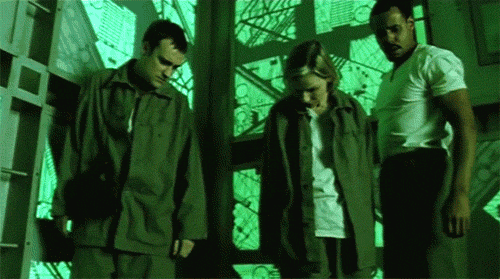
David Hewlett, Andrew Miller, Nicky Guadagni, and Maurice Dean Wint in the 1997 Canadian sci-fi horror film ‘Cube’
Six strangers wake up from their normal lives in a small room that is a perfect cube: six identical walls, with a hatch in the middle of each. When the prisoners open any one of the hatches, they find another identical room, which leads to another, which leads to another – except that some of the cubes are rigged with gruesome traps, like flesh-slicing wire and poisonous gas. How do the prisoners escape this deadly maze, and why are they there in the first place?
This is the premise of Cube, the 1997 psychological horror film that has gone on to become a cult classic. Filmed on a one-room set with a budget of $350,000 and a no-name cast, the movie anticipated the modern indie film trends of low-fi sci-fi and microbudget horror, while imbuing its story with a twisty mathematical plot and an existential edge that still feel fresh today. Plans for a remake were recently announced by Lionsgate – and honestly, it’s surprising that it took this long. As part of our Halloween horror movie coverage, Yahoo Movies spoke with Cube screenwriter Graeme Manson about his Kafka-esque nightmare in a box. [Warning: Spoilers.]
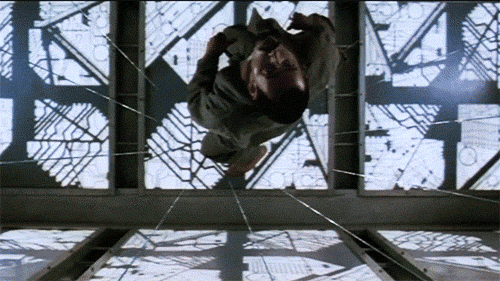
Quentin (Maurice Dean Wint) narrowly escapes from a wire trap
Right now, Manson is working on the fourth season of the BBC sci-fi hit Orphan Black (which he created with his co-showrunner John Fawcett). Fortuitously, on the day he called Yahoo Movies from the show’s Toronto set, Manson was carrying a reminder of his first professional screenwriting job. “It’s funny – this morning I grabbed this old pad of paper that had some Orphan Black notes on it, and I opened it up to the back, and in there were jammed some old Cube notes that I had saved from a move a few months ago,” Manson reveals with a laugh. “So I’m probably only able to answer your questions because I looked at these old notes here.”
Cube opens with a particularly gnarly death scene: A man wakes up in the cube-shaped room, crawls through a hatch into a neighboring cube, and is promptly sliced into bite-sized pieces by an invisible grid of razor wire. From there, the film moves to a new cube, where five characters of various ages and genders awaken and meet for the first time. All are identified by their last names, sewn onto otherwise identical uniforms: Police officer Quentin (Maurice Dean Wint); free clinic psychologist Holloway (Nicky Guadagni); prison escape artist Rennes (Wayne Robson); student mathematician Leaven (Nicole de Boer); and sullen office worker Worth (David Hewlett). Soon, the group encounters a sixth prisoner, the severely autistic Kazan (Andrew Miller).
At first, the Cube strikes the group as a puzzle they must solve, and they set out to find an escape, testing adjoining rooms for traps by throwing their boots. But after one character dies from a spray of flesh-eating acid, and another is nearly vivisected by razor wire, the survivors begin to question whether escape is even possible. Murder and madness ensue, as the characters’ true selves and darkest secrets are revealed in the desperate search for an exit.
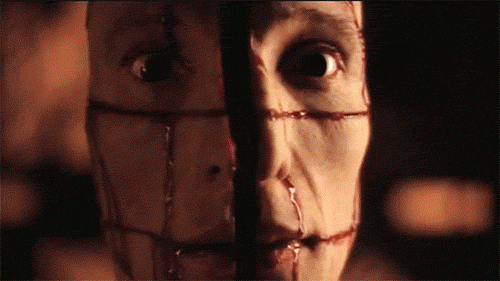
The gory death of the first victim, Alderson (played by Julian Richings)
The story of Cube began not with Manson, but with director Vincenzo Natali. “Vince was “one of those classic Super 8 directors who forced all his friends to be in his movies in high school,” says Manson. Natali’s high school friends included Cube co-screenwriter Andre Bijelic, who developed the Cube script with Natali over several years. “They had the clockworks, they had the math and the mechanics worked out, they had the puzzle,” says Manson, who befriended Natali when they were students at the Canadian Film Centre.
When Cube was selected for production through the film school’s Feature Film Project (now called CFC Features), the producers requested script revisions, and Natali brought fellow recent graduate Manson on board. Initially, “the script was essentially a sort of futuristic prison escape, very sort of militaristic, with the characters sort of being more action-oriented,” Manson recalls. “So when they brought me on, we made the decision to make it a much more character-driven piece. And I really brought the existential edge to it, I think. Because the minute [the movie becomes] six characters awake from their daily lives, trapped in a deadly maze’ it’s a different kind of horror.”
That trope of strangers trapped together in a mysterious place has fueled many an absurdist horror story, from Pirandello’s 1921 play Six Characters in Search of an Author to Jean-Paul Sartre’s 1944 play No Exit to the 1961 Twilight Zone episode Five Characters in Search of an Exit. To bring the story into Cube’s modern dystopia, Manson fleshed out the movie’s six core characters (whose surnames are, in a sly Easter egg, references to famous prisons: Rennes in France, Holloway in London, and so forth).
“We knew we wanted a cop —an authority figure who would seem most prepared to handle the situation — who would snap,” says Manson. To provide contrast to Quentin, the police officer, he came up with the doctor Holloway, a paranoid uber-liberal inspired by Manson’s own love of conspiracy theories. To further create “opposition and alliances,” the screenwriter developed four more distinct characters, including Worth, the man with secret inside knowledge of the Cube (a role written specifically for actor David Hewlett), and Leaven, the student prodigy who cracks part of the Cube’s trap code (“We always knew we wanted that [character] to be a girl,” says Manson).
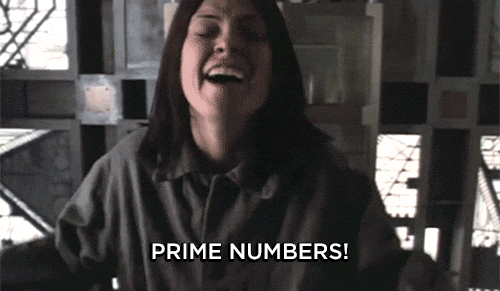
Math student Leaven (Nicole de Boer) has a breakthrough
Throughout the course of the film, the characters’ understanding of their prison continually changes. Early on, they discover that that the rooms are numbered, leading them to believe that the Cube is a solvable math problem. (The technicalities of the Cube were designed by mathematics professor David W. Pravica, credited on the film as “math consultant.”) But the numbers are more complex than they first appear; a promising escape route turns into a (literal) dead end; and as bodies pile up, the carnage, claustrophobia, and lack of food and water take a mental toll on the survivors. In the third act, the remaining characters discover a devastating clue that reveals they’ve essentially been traveling in a circle (a devise that the The Blair Witch Project would also use to great effect two years later). “I remember that [moment] being a very late discovery in the script,” says Manson. And in the end, only one person makes it out. “We liked it that that it’s the innocent that escaped,” the screenwriter says.
Unlike many horror films, Cube doesn’t provide a simple answer to the question of who is torturing its characters. Even Worth, the prisoner who was hired to design the Cube doesn’t know why it exists. It’s “an accident, a forgotten, perpetual public works project,” he tells the other room-dwellers. The villain is “boundless human stupidity,” a prospect much scarier than any boogeyman. “People always look for reasons for things, and [Natali and I] liked the fact that this thing could just be there, could just be existing, and people are being put in it because it’s someone’s job to put someone in it,” says Manson. “And [the idea that] as a species, that we create our own problems together, by our own indifference and lack of responsibility, and that good and evil sometimes aren’t really something you can hang your hat on…. We compartmentalize things, find ways to justify our actions, because none of us can see the whole picture.’”
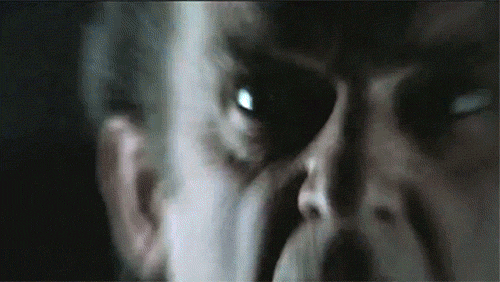
Rennes (Wayne Robson) is sprayed with acid in one of the Cube’s traps
Cube premiered at the 1997 Toronto International Film Festival, where it won the award for Best Canadian First Feature. The film opened in limited release in the United States in 1998, and expanded to an internationally release over the next three years. “It had strange legs in odd places,” says Manson. “It did really well in Japan, where people, I think, live with a sense of claustrophobia. And it did very well in France, where people live with a sense of ennui.” The film wasn’t a box office smash, but it did turn a profit, grossing half a million dollars worldwide. After a home video release, the buzz surrounding Cube became substantial enough that two sequels were produced: 2002’s Hypercube (in which the Cube transcends time and space) and 2004’s Cube Zero (a prequel about the men hired to operate the Cube). Neither film involved Natali or Manson, who pitched their own sequel – but the studio didn’t bite. “We had our own story that we wanted to tell, and I believe they weren’t that interested in our story, so we said, ‘Go with God,’” says Manson. “We wanted to do a backstory, but I don’t think we actually pursued it very far.”
Manson has never seen the Cube sequels, and learned about the upcoming remake from the trade papers. “It’s funny, nobody tells you they’re remaking a movie you worked on,” he says. “Don’t even know who is doing it. But I hope don’t just make an effects-based movie. I hope they dig deep into the psychology of it.”

